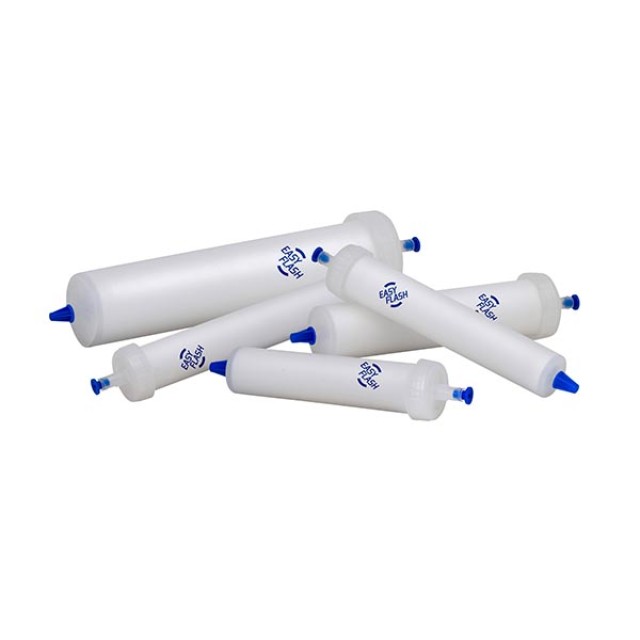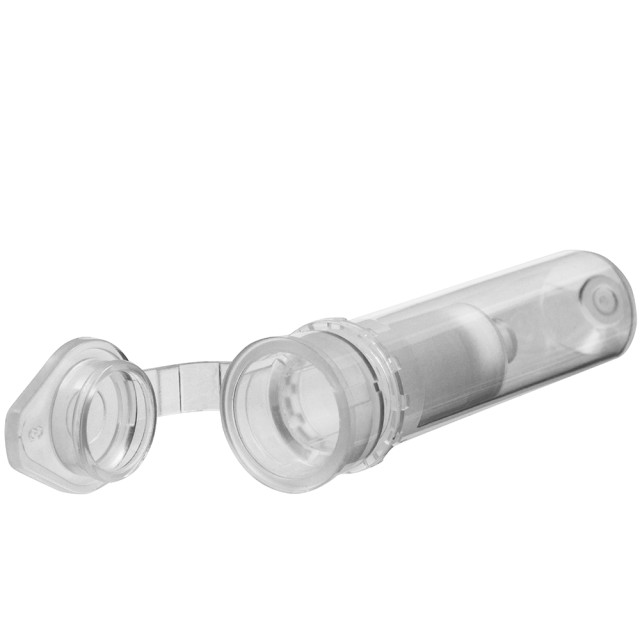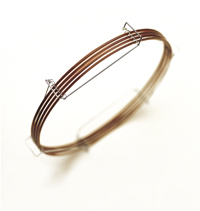

 0
Porovnat
0
Porovnat
 Uživatel
Uživatel
 0
Košík
0
Košík

Stacionární fáze
EasyFlash kolony
Chromservis uvedl na trh nové kolony EasyFlash pro vysoce účinnou flash chromatografii. V tomto článku se dozvíte o výhodách flash chromatografie.
Stacionární fáze pro HPLC
ASTRA - CHROMSERVIS
| Typ fáze | Velikost částic (µm) | Velikost pórů (Å) | Plocha povrchu (m2/g) | % uhlíku | Rozsah pH |
|---|---|---|---|---|---|
| C18-HE | 2, 3, 5, 10 | 100 | 330 | 17 | 2-9 |
| C18-AQ | 2. 3, 5 | 100 | 330 | 13 | 2-9 |
| C18-BDS | 3, 5 | 140 | 170 | 11 | 2-8 |
| C8-HE | 5 | 100 | 330 | 11 | 2-9 |
| C8-BDS | 3, 5 | 140 | 170 | 6 | 2-8 |
| Phenyl-Hexyl-HE | 3, 5 | 100 | 330 | 11 | 2-7.5 |
| DM | 3, 5 | 100 | 205 | 12 | 2-9 |
| Diol | 3, 5 | 100 | 330 | 5 | 2-7.5 |
| Si | 3,5 | 100 | 330 | - | 2-8 |
ARION - CHROMSERVIS
| Typ fáze | Velikost částic (µm) | Velikost pórů (Å) | Plocha povrchu (m2/g) | % uhlíku | Rozsah pH |
|---|---|---|---|---|---|
| Plus C18 | 1.7, 2.2, 3, 5, 10, 15 | 100 | 420 | 18 | 1.5-10 |
| Polar C18 | 2.2, 3, 5, 10, 15 | 120 | 325 | 16 | 1.5-7.0 |
| C8 | 3, 5 | 120 | 325 | 11 | 2.0-7.0 |
| Phenyl-butyl | 2.2, 3, 5 | 100 | 300 | 12 | 1.5-7.5 |
| NH2 | 2.2, 3, 5 | 120 | 325 | 5 | 2.0-6.5 |
| CN | 3, 5, 10 | 120 | 325 | 8 | 2.0-7.0 |
| HILIC Plus | 2.2, 3, 5 | 120 | 420 | - | 1.5-7.0 |
| Si | 2.2, 3, 5, 10 | 100 | 420 | - | 1.5-7.0 |
| SAX | 5 | 120 | 325 | - | 1.0-7.5 |
| SCX | 5 | 120 | 325 | - | 1.0-7.5 |
Na našich stránkách naleznete i návod, jak se starat o (U)HPLC kolony Arion.
CHROMSHELL - CHROMSERVIS
| Typ fáze | Velikost částic (µm) | Velikost pórů (Å) | Efektivní plocha povrchu (m2/g) | % uhlíku | Rozsah pH |
|---|---|---|---|---|---|
| CHROMSHELL® C18 Plus | 2.6 | 85 | 130 | 9 | 1.5-7.5 |
| CHROMSHELL® C18-XB | 2.6 | 85 | 130 | 8 | 1.5-8.0 |
| CHROMSHELL® C18 Polar | 2.6 | 85 | 130 | 6.5 | 1.5-7.0 |
KINETEX - PHENOMENEX
| Typ fáze | Velikost částic (µm) | Velikost pórů (Å) | Efektivní plocha povrchu (m2/g) | % uhlíku | Rozsah pH |
|---|---|---|---|---|---|
| Kinetex XB-C18 | 5, 2.6 | 100 | 200 | 10 | 1.5-8.5* |
| Kinetex C18 | 5, 2.6 | 100 | 200 | 12 | 1.5-8.5* |
| Kinetex C8 | 2.6 | 100 | 200 | 8 | 1.5-8.5* |
| Kinetex PFP | 5, 2.6 | 100 | 200 | 9 | 1.5-8.5* |
| Kinetex HILIC | 2.6 | 100 | 200 | 0 | 2.0-7.5 |
| Kinetex Phenyl-Hexyl | 5, 2.6 | 100 | 200 | 11 | 1.5-8.5* |
*Kolony mají stabilitu v rozsahu pH 1.5 až 10 za isokratických podmínek. Při gradientních elucích je jejich stabilita v rozsahu pH 1.5 až 8.5.
Kolony Kinetex 2.6µm s ID 2.1mm jsou stabilní do tlaku 1000 bar, jinak do 600 bar.
Vyzkoušejte kolony ChromShell, kterými kolony Kinetex můžete nahradit.
LUNA - PHENOMENEX
| Typ fáze | Velikost částic (µm) | Velikost pórů(Å) | Plocha povrchu (m2/g) | % uhlíku | Rozsah pH | USP kód |
|---|---|---|---|---|---|---|
| Luna Phenyl-Hexyl | 3,5,10,15 | 100 | 400 | 17.5 | 1.5-10.0 | L11 |
| Luna Silica (2) | 3,5,10,15 | 100 | 400 | - | - | L3 |
| Luna C5 | 5,10 | 100 | 440 | 12.5 | 1.5-10.0 | - |
| Luna C8 | 5,10 | 100 | 440 | 14.75 | 1.5-10.0 | L7 |
| Luna C8 (2) | 3,5,10,15 | 100 | 400 | 13.5 | 1.5-10.0 | L7 |
| Luna C18 | 5,10 | 100 | 440 | 19 | 1.5-10.0 | L1 |
| Luna C18 (2) | 2.5,3,5,10,15 | 100 | 400 | 17.5 | 1.5-10.0 | L1 |
| Luna CN | 3,5,10 | 100 | 400 | 7.0 | 1.5-10.0 | L10 |
| Luna NH2 | 3,5,10 | 100 | 400 | 9.5 | 1.5-11.0 | L8 |
| Luna SCX | 5,10 | 100 | 400 | 0.55% Sulfur Load | 2.0-7.0 | L9 |
| Luna HILIC | 3,5 | 200 | 200 | - | 1.5-8.0 | - |
| Luna PFP(2) | 3 5 | 100 | 400 | 5.7 | 1.5-8.0 | L43 |
GEMINI - PHENOMENEX
| Typ fáze | Velikost částic (µm) | Velikost pórů (Å) | Plocha povrchu (m2/g) | % uhlíku | Rozsah pH | USP kód |
|---|---|---|---|---|---|---|
| Gemini C18 | 3,5,10 | 110 | 375 | 14 | 1.0-12.0 | L1 |
| Gemini C6-Phenyl | 3,5 | 110 | 375 | 12 | 1.0-12.0 | L11 |
| Gemini NX | 3,5,10 | 110 | 375 | 14 | 1.0-12.0 | L1 |
SYNERGI - PHENOMENEX
| Typ fáze | Velikost částic (µm) | Velikost pórů(Å) | Plocha povrchu (m2/g) | % uhlíku | Rozsah pH | USP kód |
|---|---|---|---|---|---|---|
| Synergi Max-RP | 2.5 | 100 | 400 | 17 | 1.5-10.0 | - |
| Synergi Hydro-RP | 2.5 | 100 | 400 | 19 | 1.5-7.5 | L1 |
| Synergi Polar-RP | 2.5 | 100 | 440 | 11 | 1.5-7.0 | L11 |
| Synergi Fusion-RP | 2.5 | 100 | 440 | 12 | 1.5-10.0 | L1 |
| Synergi Max-RP | 4,10 | 80 | 475 | 17 | 1.5-10.0 | - |
| Synergi Hydro-RP | 4,10 | 80 | 475 | 19 | 1.5-7.5 | L1 |
| Synergi Polar-RP | 4,10 | 80 | 475 | 11 | 1.5-7.0 | L11 |
| Synergi Fusion-RP | 4,10 | 80 | 475 | 12 | 1.5-10.0 | L1 |
ONYX - PHENOMENEX
| Typ fáze | Velikost makropórů (µm) | Velikost pórů (Å) | Plocha povrchu (m2/g) | % uhlíku | Rozsah pH | USP kód |
|---|---|---|---|---|---|---|
| Onyx Silica | 2 | 130 | 300 | 0 | 2.0-7.5 | - |
| Onyx C8 | 2 | 130 | 300 | 11 | 2.0-7.5 | - |
| Onyx C18 | 2 | 130 | 300 | 18 | 2.0-7.5 | - |
JUPITER - PHENOMENEX
| Typ fáze | Velikost částic (µm) | Velikost pórů (Å) | Plocha povrchu (m2/g) | % uhlíku | Rozsah pH | USP kód |
|---|---|---|---|---|---|---|
| Jupiter C4 | 5,10,15 | 300 | 170 | 5.0 | 1.5-10.0 | L26 |
| Jupiter C5 | 5,10,15 | 300 | 170 | 5.5 | 1.5-10.0 | - |
| Jupiter C18 | 5,10,15 | 300 | 170 | 13.3 | 1.5-10.0 | L1 |
| Jupiter Proteo C12 | 4,10 | 90 | 475 | 15.0 | 1.5-10.0 | - |
GraceSmart - GRACE
| Typ fáze | Velikost částic(µm) | Velikost pórů (Å) | Plocha povrchu (m2/g) | % uhlíku | Rozsah pH | USP kód |
|---|---|---|---|---|---|---|
| GraceSmart C18 | 3,5 | 120 | 220 | 10 | 2.0-9.0 | L1 |
Alltech® Prevail - GRACE
| Typ fáze | Velikost částic(µm) | Velikost pórů (Å) | Plocha povrchu (m2/g) | % uhlíku | Rozsah pH | USP kód |
|---|---|---|---|---|---|---|
| Prevail C18 | 3,5 | 110 | 350 | 17 | L1 | |
| Prevail C18 Select | 3,5 | 110 | 350 | 15 | L1 | |
| Prevail C8 | 3,5 | 110 | 350 | 8 | L7 | |
| Prevail Phenyl | 3,5 | 110 | 350 | 7 | L11 | |
| Prevail Cyano (CN) | 3,5 | 110 | 350 | - | L10 | |
| Prevail Amino (NH2) | 3,5 | 110 | 350 | - | L8 | |
| Prevail Silica | 3,5 | 110 | 350 | - | L3 | |
| Prevail Organic Acid | 3,5 | 110 | 350 | - | - | |
| Carbohydrate ES (polymer) | 5 | - | - | - | - |
Kapilární / Nano LC kolony ProteCol - SGE
| Typ fáze | Velikost částic(µm) | Velikost pórů (Å) | Plocha povrchu (m2/g) | % uhlíku | Rozsah pH | USP kód |
|---|---|---|---|---|---|---|
| ProteCol C18 | 3 | 120/300 | 350 | 17 | 2.0-7.5 | L1 |
| ProteCol C8 | 3 | 120/300 | 350 | 10 | 2.0-7.5 | L7 |
| ProteCol C4 | 3 | 120/300 | 350 | 2.0-7.5 | L26 | |
| ProteCol SCX | 3 | 120/300 | 350 | 2.0-7.5 | L9 |
Přehled sorbentů MSPE
Sorbenty pro techniku MSPE jsou zvoleny tak, aby pokryly co nejširší pole aplikací. MSPE SpeExtra C18 je hydrofóbní typ oktadecyl silikagelu se speciálním endcappingem s velmi širokým uplatněním. Je vhodný pro celou řadu analytů, horší retenci vykazuje pro polární sloučeniny. MSPE SpeExtra C18-P je polárně modifikovaný monomerní oktadecyl silikagel . Nabízí různé typy interakcí: dipól-dipól, π- π a hydrofóbní. Je tedy vhodný pro aromatické a polární sloučeniny. MSPE SpeExtra HLB polymerní sorbent s vysokým měrným povrchem a speciálním endcappingem. Má hydrofilní a lipofilní modifikaci zajišťující univerzální použití a vyšší kapacitu než C18 silikagel. MSPE SpeExtra WAX je polymerní sorbent na bázi PS/DVB se speciálním end-cappingem a vysoce specifickým povrchem, který se připravuje kopolymerací styrenu a divinylbenzenu, přičemž vytváří slabé aniontové interakce.
| MSPE sorbent | Velikost částic [µm] | Měrný povrch [m2/g] |
| C18 | 60 | 310 |
| C18-P | 60 | 310 |
| HLB | 30 | 850 |
| WAX | 30 | 850 |
Fáze pro SPE
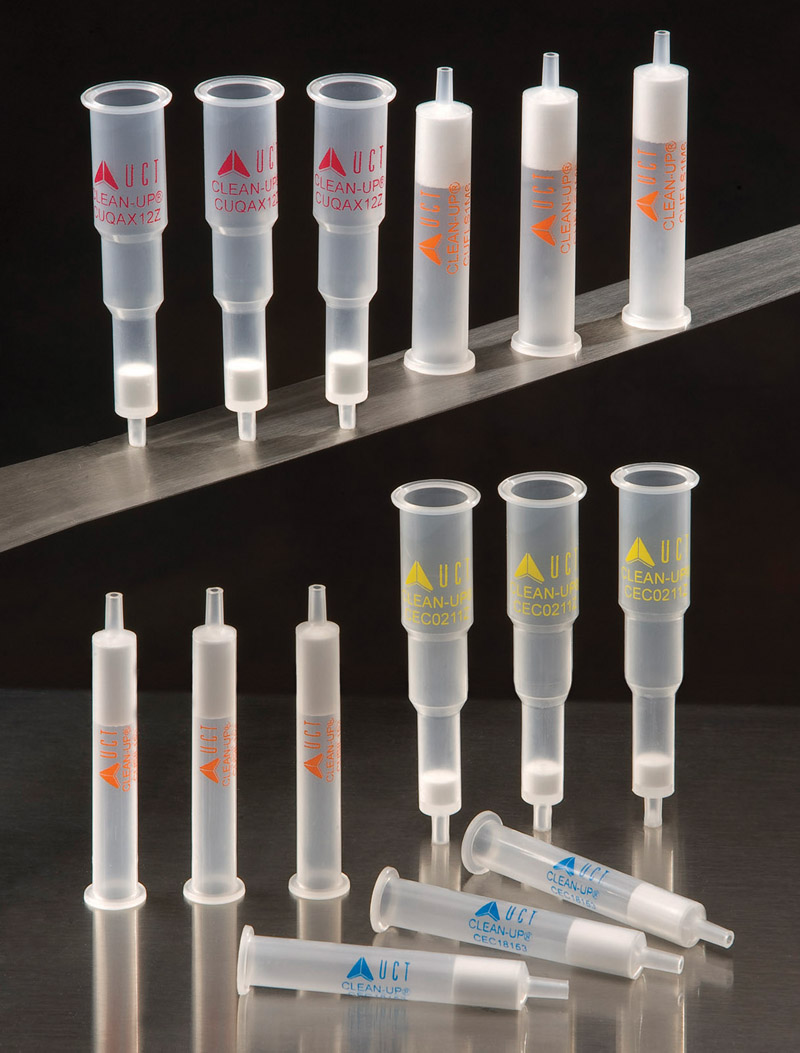
Na této stránce uvádíme přehled nabízených kolonek pro extrakci na pevné fázi (SPE) včetně technických parametrů. Další informace k produktům najdete v katalogu zboží, ve kterém jsou uvedeny SPE kolonky a disky, dSPE produkty, manifoldy, produkty pro on-line SPE a vakuová čerpadla.
Clean up SPE kolonky
Reverzní fáze hydrofobní
| Phase | Particle size (µm) | Pore Size (A) | Surface Area (m2/g) | Carbon Load (%) | End Capping | Feature |
|---|---|---|---|---|---|---|
| C2 Ethyl | 60 | 500 | 6,6 | YES/NO | ||
| C4 n-Butyl | 60 | 500 | 8,5 | YES | ||
| C8 Octyl | 60 | 500 | 11,1 | YES/NO | ||
| C18 Octadecyl | 60 | 500 | 21,7 | YES/NO | ||
| C30 Tricontyl | 60 | 500 | 20,0 | YES | ||
| Cyclohexyl | 60 | 500 | 11,6 | YES/NO | ||
| Phenyl | 60 | 500 | 11,0 | YES/NO |
Normální fáze hydrofilní
| Phase | Particle size (µm) | Pore Size (A) | Surface Area (m2/g) | Carbon Load (%) | Feature | |
|---|---|---|---|---|---|---|
| Silica | 0,77 | 60 | 500 | N/A | ||
| Diol | 0,77 | 60 | 500 | 8,0 | ||
| Cyanopropyl | 0,77 | 60 | 500 | 9,0 | ||
| Florisil | 0,82 | 60 | 500 | N/A | ||
| Alumina, Acidic | 60 | 500 | N/A | |||
| Alumina, Basic | 60 | 500 | N/A | |||
| Alumina, Neutral | 60 | 500 | N/A | |||
| Carbon | N/A | 120/140 mesh |
Ion Anion Exchange fáze
| Phase | Pore volume (cm3/g) | pKa | Pore Size (A) | Surface Area (m2/g) | Carbon Load (%) | Exchange (meq/g) |
|---|---|---|---|---|---|---|
| Aminopropyl (1 amine) | 0,77 | 9.8 | 60 | 500 | 6,65 | 0,31 |
| N-2 Aminoethyl (1/2 amine) | 0,77 | 10.1; 10.9 | 60 | 500 | 11,1 | 0,32 |
| Diethylamino (3 amine) | 0,77 | 10.6 | 60 | 500 | 10,6 | 0,28 |
| Quarternary Amine Chloride | 0.77 | Always charged | 60 | 500 | 8,4 | 0,25 |
| Quarternary Amine Hydroxide | 0.77 | Always charged | 60 | 500 | 8,4 | 0,25 |
| Quarternary Amine Acetate | 0.77 | Always charged | 60 | 500 | 8,4 | 0,25 |
| Quarternary Amine Formate | 0.77 | Always charged | 60 | 500 | 8,4 | 0,25 |
| Polyimine | 0,77 | Always charged | 13,5 | 0,25 |
Ion Cation Exchange fáze
| Phase | Pore volume (cm3/g) | pKa | Pore Size (A) | Surface Area (m2/g) | Carbon Load (%) | Exchange (meq/g) |
|---|---|---|---|---|---|---|
| Carboxylic Acid | 0.77 | 4.8 | 60 | 500 | 9,2 | 0,17 |
| Propylsulfonic Acid | 0.77 | 1 | 60 | 500 | 7,1 | 0,18 |
| Benzenesulfonic Acid | 0.77 | Always charged | 60 | 500 | 11,0 | 0,32 |
| Benzenesulfonic Acid, High Load | 0.77 | Always charged | 60 | 500 | 15,0 | 0,65 |
| Triacetic Acid | 0,77 | 60 | 500 | 7,61 | Anion 0,17/Cation 0,06 |
Kopolymerní fáze
| Phase | Pore volume (cm3/g) | pKa | Pore Size (A) | Surface Area (m2/g) | Carbon Load (%) | Exchange (meq/g) |
|---|---|---|---|---|---|---|
| Aminopropyl + C8 | 0.77 | 9,8 | 60 | 500 | 12,3 | 0,163 |
| Quarternary Amine + C8 | 0.77 | Always charged | 60 | 500 | 13,6 | 0,160 |
| Carboxylic Acid + C8 | 0.77 | 4,8 | 60 | 500 | 2,5 | 0,105 |
| Propylsulfonic Acid + C8 | 0.77 | 1 | 60 | 500 | 14,62 | 0,114 |
| Benzenesulfonic Acid + C8 | 0,77 | Always charged | 60 | 500 | 12.3 | 0,072 |
| Cyanopropyl + C8 | 0,77 | N/A | 60 | 500 | 14,6 | 0,163 |
| Cyclohexyl + C8 | 0.77 | N/A | 60 | 500 | N/A | N/A |
Stacionární fáze pro GC
Na této stránce uvádíme přehled dodávaných stacionárních fází pro plynovou chromatografii (GC). U každé jsou uvedeny podrobné údaje o jejích vlastnostech a aplikacích, které jsou pro ně vhodné. V katalogu produktů si pak můžete vybrat vhodnou křemennou či kovovou kapilární kolonu pro GC.
Stacionární fáze LION
Křemenné kapilární kolony
| Stacionární fáze | Teplotní limity | Chemické složení | USP kód |
|---|---|---|---|
| LN-1 | -60 až 370°C | 100% dimetyl polysiloxan | G2 |
| LN-1 MS | -60 až 370°C | 100% dimetyl polysiloxan | G2 |
| LN-1 HT | -60 až 430°C | 100% dimetyl polysiloxan | - |
| LN-5 | -60 až 370°C | 5% difenyl/95% dimetyl polysiloxan | G27 |
| LN-5 Sil MS | -60 až 370°C | 5% difenyl/95% dimetyl polysiloxan | G27 |
| LN-5 MS | -60 až 350°C | 5% fenyl - arylen - 95% dimetyl polysiloxan | G27 |
| LN-5 HT | -60 až 430°C | 5% difenyl/95% dimetyl polysiloxan | - |
| LN-35 | 50 až 360°C | 35% difenyl/65% dimetyl polysiloxan | G42 |
| LN-35 HT | -60 až 400°C | 35% difenyl/65% dimetyl polysiloxan | G42 |
| LN-17 MS | 40 až 340°C | 50% dipenyl/50% dimetyl polysiloxan | G3 |
| LN-624 | -20 až 260°C | 6% kyanopropylfenyl/94% dimetyl polysiloxan | G43 |
| LN-FFAP | 40 až 260°C | Polyetylén glykol modifikovaný kyselinou nitrotereftalovou | G35 |
| LN-1701 | -20 až 300°C | 14% kyanopropylfenyl/86% dimetyl polysiloxan | G46 |
| LN-XLB | 30 až 360°C | Fáze s nízkou polaritou | - |
| LN-XLB-HT | 30 až 400°C | Fáze s nízkou polaritou | - |
| LN-WAX | 40 až 260°C | Polyetylen glykol | G16 |
| LN-WAX Plus | 20 až 260°C | Polyetylen glykol | G16 |
Stacionární fáze Restek
Křemenné kapilární kolony
| Stacionární fáze | Teplotní limity | Chemické složení | USP kód |
|---|---|---|---|
| Rxi®-1MS | -60 až 350°C | 100% dimetyl polysiloxan | G2 |
| Rxi®-1HT | -60 až 400°C | 100% dimetyl polysiloxan | |
| Rxi®-5MS | -60 až 350°C | 5% difenyl/95% dimetyl polysiloxan | G27 |
| Rxi®-5Sil MS | -60 až 350°C | silarylenová fáze (selektivita jako 5% fenyl 95%dimetyl polysiloxan) | - |
| Rxi®-5HT | -60 až 400°C | 5% difenyl/95% dimetyl polysiloxan | - |
| Rxi®-XLB | 30 až 360°C | fáze s nízkou polaritou | - |
| Rxi®-35Sil MS | 50 až 360°C | aplikačně specifická fáze (selektivita jako 35% difenyl/65% dimetyl polysiloxan) | - |
| Rxi®-624Sil MS | -60 až 320°C | silarylenová fáze (selektivita jako 6% kyanopropylfenyl/94% dimetyl polysiloxan) | - |
| Rxi®-17 | 40 až 320°C | 50% difenyl/50% dimetyl polysiloxan | - |
| Rxi®-17Sil MS | 40 až 360°C | silarylenová fáze (selektivita jako 100% fenylmetyl polysiloxan) | G3 |
| Rtx®-1 | -60 až 350°C | 100% dimetyl polysiloxan | G1,G2,G38 |
| Rtx®-1 F&F | -60 až 350°C | 100% dimetyl polysiloxan (optimalizovaný) | - |
| Rtx®-1PONA | -60 až 340°C | 100% dimetyl polysiloxan (optimalizovaný) | - |
| Rtx®-2887 | -60 až 360°C | 100% dimetyl polysiloxan (optimalizovaný) | - |
| Rtx®-5 | -60 až 350°C | 5% difenyl/95% dimetyl polysiloxan | G27,G36 |
| Rtx®-5 Amine | -60 až 315°C | 5% difenyl/95% dimetyl polysiloxan (optimalizovaný) | - |
| Rtx®-5 PONA | 60 až 325°C | 5% difenyl/95% dimetyl polysiloxan (optimalizovaný) | - |
| Rtx®-1301 | -20 až 280°C | 6% kyanopropylfenyl/94% dimetyl polysiloxan | G43 |
| Rtx®-624 | -20 až 240°C | 6% kyanopropylfenyl/94% dimetyl polysiloxan | G43 |
| Rtx®-20 | -20 až 320°C | 20% difenyl/80% dimetyl polysiloxan | G28,G32 |
| Rtx®-35 | 40 až 320°C | 35% difenyl/65% dimetyl polysiloxan | G42 |
| Rtx®-35 MS | 40 až 320°C | 35% difenyl/65% dimetyl polysiloxan (optimalizovaný) | G42 |
| Rtx®-35 Amine | 40 až 320°C | 35% difenyl/65% dimetyl polysiloxan (optimalizovaný) | G42 |
| Rtx®-1701 | -20 až 280°C | 14% kyanopropylfenyl/86% dimetyl polysiloxan | G46 |
| Rtx®-200 | -20 až 340°C | Trifluoropropylmetyl polysiloxan | G6 |
| Rtx®-200MS | -20 až 340°C | Trifluoropropylmetyl polysiloxan | G6 |
| Rtx®-50 | 40 až 320°C | 100% metylfenyl polysiloxan | G3 |
| Rtx®-65 | 50 až 300°C | 65% difenyl/35% dimetyl polysiloxan | G17 |
| Rtx®-65TG | 40 až 370°C | 65% difenyl/35% dimetyl polysiloxan (optimalizovaný) | - |
| Rtx®-225 | 40 až 240°C | 50% kyanopropylmetyl/50% fenylmetyl polysiloxan | G7,G19 |
| Rtx®-440 | 20 až 340°C | Středně polární fáze | - |
| Rtx®-Wax | 20 až 250°C | Carbowax® polyetylen glykol | G14,G15,G16 |
| Stabilwax® | 40 až 250°C | Carbowax® polyetylen glykol | G14,G15,G16 |
| Stabilwax®-DB | 40 až 250°C | Carbowax® polyetylen glykol | - |
| Stabilwax®-DA | 40 až 250°C | Carbowax® polyetylen glykol | G25,G35 |
| FAMEWAX | 20 až 250°C | Polyetylen glykol | - |
| Rt™-CW20M F&F | 60 až 220°C | Carbowax® polyetylen glykol | - |
| Rt™-2330 | 0 až 275°C | Biskyanopropyl polysiloxan | G48 |
| Rt™-2560 | 20 až 250°C | 90% biskyanopropyl/10% fenylkyanopropyl polysiloxan | - |
| Stx™-500 | -60 až 380°C | Karboran/dimetyl polysiloxan | - |
| Rtx®-VMS | -40 až 260°C | Aplikačně specifická fáze | - |
| Rtx®-502.2 | -20 až 270°C | Aplikačně specifická fáze | - |
| Rtx®-VRX | -40 až 260°C | Aplikačně specifická fáze | - |
| Rtx®-VGC | -40 až 260°C | Aplikačně specifická fáze | - |
| Rtx®-Volatiles | -20 až 280°C | Aplikačně specifická fáze | - |
| Rtx®-CLPesticides | -60 až 340°C | Aplikačně specifická fáze | - |
| Rtx®-CLPesticides2 | -60 až 340°C | Aplikačně specifická fáze | - |
| Stx™-CLPesticides | -60 až 330°C | Aplikačně specifická fáze | - |
| Stx™-CLPesticides2 | -60 až 330°C | Aplikačně specifická fáze | - |
| Rtx®-OPPesticides | -20 až 330°C | Aplikačně specifická fáze | - |
| Rtx®-OPPesticides2 | -20 až 330°C | Aplikačně specifická fáze | - |
| Rtx®-Dioxin | -60 až 380°C | Aplikačně specifická fáze | - |
| Rtx®-Dioxin2 | 20 až 340°C | Aplikačně specifická fáze | - |
| Rtx®-PCB | 30 až 340°C | Aplikačně specifická fáze | - |
| Rtx®-1614 | -60 až 360°C | Aplikačně specifická fáze | - |
| Rt™-PAH | 80 až 285°C | Fáze z tekutých krystalů | - |
| Rtx®-TNT | -20 až 310°C | Aplikačně specifická fáze | - |
| Rtx®-TNT 2 | -20 až 310°C | Aplikačně specifická fáze | - |
| Rtx®-Biodiesel TG | do 380°C | Aplikačně specifická fáze | - |
| Rt™-TCEP | 0 až 135°C | 1,2,3-tris[2-kyanoetoxy]propan | - |
| Rtx®-BAC1 | -20 až 260°C | Aplikačně specifická fáze | - |
| Rtx®-BAC2 | -20 až 260°C | Aplikačně specifická fáze | - |
| Rt™-ßDEXcst | 40 až 230°C | Chirální fáze | - |
| Rt™-ßDEXm | 40 až 230°C | Chirální fáze | - |
| Rt™-ßDEXsa | 40 až 230°C | Chirální fáze | - |
| Rt™-ßDEXse | 40 až 230°C | Chirální fáze | - |
| Rt™-ßDEXsm | 40 až 230°C | Chirální fáze | - |
| Rt™-ßDEXsp | 40 až 230°C | Chirální fáze | - |
| Rt™-yDEXsa | 40 až 230°C | Chirální fáze | - |
Kovové kapilární kolony
| Stacionární fáze | Teplotní limity | Chemické složení | USP kód |
|---|---|---|---|
| MXT®-1 | -60 až 430°C | 100% dimetyl polysiloxan | G1,G2,G38 |
| MXT®-1HT SimDist | -60 až 430°C | Aplikačně specifická fáze | - |
| MXT®-1 SimDist | -60 až 430°C | Aplikačně specifická fáze | - |
| MXT®-2887 | -60 až 400°C | Aplikačně specifická fáze | - |
| MXT®-5 | -60 až 430°C | 5% difenyl/95% dimetyl polysiloxan | G27,G36 |
| MXT®-20 | -20 až 320°C | 20% difenyl/80% dimetyl polysiloxan | G28,G32 |
| MXT®-35 | 0 až 310°C | 35% difenyl/65% dimetyl polysiloxan | G42 |
| MXT®-50 | 0 až 290°C | 100% metylfenyl polysiloxan | G3 |
| MXT®-65 | 50 až 300°C | 65% difenyl/35% dimetyl polysiloxan | G17 |
| MXT®-65TG | 20 až 370°C | 65% difenyl/35% dimetyl polysiloxan (optimalizovaný) | - |
| MXT®-624 | -20 až 240°C | 6% kyanopropylfenyl/94% dimetyl polysiloxan | G43 |
| MXT®-1301 | -20 až 280°C | 6% kyanopropylfenyl/94% dimetyl polysiloxan | G43 |
| MXT®-1701 | -20 až 280°C | 14% kyanopropylfenyl/86% dimetyl polysiloxan | G46 |
| MXT®-200 | -20 až 400°C | Trifluoropropylmetyl polysiloxan | G6 |
| MXT®-WAX | 40 až 260°C | Carbowax® polyetylen glykol | G14,G15,G16 |
| MXT®-500 SimDist | -60 až 430°C | Karboran-siloxanový polymer | - |
| MXT®-502.2 | -20 až 270°C | Aplikačně specifická fáze | - |
| MXT®-Biodiesel TG | -60 až 430°C | Aplikačně specifická fáze | - |
| MXT®-Volatiles | -20 až 280°C | Aplikačně specifická fáze | - |
PLOT kolony
| Stacionárne fázy | Teplotné limity | Chemické zloženie | USP kód |
|---|---|---|---|
| Rt®-Alumina BOND | do 200°C | Al2O3 (Na2SO4 deaktivace) | - |
| Rt®-Alumina BOND | do 200°C | Al2O3 (KCl deaktivace) | |
| Rt®-Msieve 13X | do 300°C | Molekulové síto 13X | - |
| Rt®-Msieve 5A | do 300°C | Molekulové síto 5A | - |
| Rt®-Q-BOND | do 320°C | 100% divinylbenzen | - |
| Rt®-QS-BOND | do 250°C | Porézny divinylbenzen homopolymer | - |
| Rt®-S-BOND | do 250°C | Divinylbenzen 4-vinylpyridin | - |
| Rt®-U-BOND | do 190°C | Divinylbenzen etylenglykol/dimetylakrylát | - |
Kovové plot kolony
| Stacionární fáze | Teplotní limit | Chemické složení | USP kód |
|---|---|---|---|
| Mtx®-Alumina Bond | až 200°C | Al2O3 (Na2SO4 deaktivace) | - |
| Mtx®-MSieve 5A | až 300°C | Molekulové síto 5A | - |
Stacionární fáze SGE
Křemenné kapilární kolony
| Stacionární fáze | Teplotní limity | Chemické složení | USP kód |
|---|---|---|---|
| forte BP1 | -60 až 360°C | 100% dimetyl polysiloxan | G1,G2,G38 |
| forte SolGel 1MS | 0 až 380°C | 100% dimetyl polysiloxan | G1,G2,G38 |
| forte BPX1 | -30 až 430°C | 100% dimetyl polysiloxan (optimalizovaný) | - |
| forte BP1 PONA | -60 až 360°C | 100% dimetyl polysiloxan (optimalizovaný) | - |
| forte BP5 | -60 až 360°C | 5% fenyl metyl polysiloxane | G28,G32 |
| forte BPX5 | -40 až 370°C | 5% fenyl polysilfenylene siloxan | - |
| forte HT5 | 10 až 400°C | 5% fenyl polykarboran siloxan | - |
| forte HT8 | -20 až 370°C | 8% fenyl polykarboran siloxan | - |
| forte BPX35 | 0 až 370°C | 35% fenyl polysilfenylen siloxan | G42 |
Stacionární fáze pro UHPLC
Raptor - RESTEK
| Typ fáze | Velikost částic (µm) | Velikost pórů (Å) | Efektivní plocha povrchu (m2/g) | Obsah uhlíku (%) | Rozsah pH |
|---|---|---|---|---|---|
| Raptor ARC-C18 | 1.8 | 90 | 125 | neveřejné | 1.0-8.0 |
| Raptor ARC-C18 | 2.7 | 90 | 130 | neveřejné | 1.0-8.0 |
| Raptor ARC-C18 | 5.0 | 90 | 100 | neveřejné | 1.0-8.0 |
| Raptor C18 | 1.8 | 90 | 125 | neveřejné | 2.0-8.0 |
| Raptor C18 | 2.7 | 90 | 130 | neveřejné | 2.0-8.0 |
| Raptor C18 | 5.0 | 90 | 100 | neveřejné | 2.0-8.0 |
| Raptor Biphenyl | 1.8 | 90 | 125 | neveřejné | 1.5-8.0 |
| Raptor Biphenyl | 2.7 | 90 | 130 | neveřejné | 1.5-8.0 |
| Raptor Biphenyl | 5.0 | 90 | 100 | neveřejné | 1.5-8.0 |
| Raptor Fluorophenyl | 1.8 | 90 | 125 | neveřejné | 2.0-8.0 |
| Raptor Fluorophenyl | 2.7 | 90 | 130 | neveřejné | 2.0-8.0 |
| Raptor Fluorophenyl | 5.0 | 90 | 100 | neveřejné | 2.0-8.0 |
| Raptor HILIC-Si | 2.7 | 90 | 150 | n/a | 2.0-8.0 |
| Raptor EtG/EtS | 2.7 | 90 | 130 | neveřejné | 2.0-8.0 |
Maximální tlak kolon Raptor je: 1,034 bar (1.8 μm), 600 bar (2.7 μm); 400 bar (5 μm). Pro delší životnost doporučujeme tlak pro kolony 1.8 µm maximálně 830 bar.
PINNACLE DB - RESTEK
| Typ fáze | Velikost částic(µm) | Velikost pórů (Å) | Plocha povrchu (m2/g) | Obsah uhlíku (%) | Rozsah pH |
|---|---|---|---|---|---|
| Pinnacle DB C18 | 1.9 | 140 | 150 | 11 | 2.5-8.0 |
| Pinnacle DB Aqueous C18 | 1.9 | 140 | 150 | 6 | 2.5-8.0 |
| Pinnacle DB C8 | 1.9 | 140 | 150 | 6 | 2.5-8.0 |
| Pinnacle DB CN | 1.9 | 140 | 150 | 4 | 2.5-8.0 |
| Pinnacle DB PFP | 1.9 | 140 | 150 | 6 | 2.5-8.0 |
| Pinnacle DB Biphenyl | 1.9 | 140 | 150 | 8 | 2.5-8.0 |
| Pinnacle DB IBD | 1.9 | 140 | 150 | neveřejné | 2.5-8.0 |
| Pinnacle DB Silica | 1.9 | 140 | 150 | n/a | 2.5-8.0 |
dSPE (QuEChERS)
Produkty Resprep™ QuEChERS
Extrakční a Clean-Up dSPE zkumavky QuEChERS pro reziduální analýzu pesticidů v potravinách
- Rychlá, jednoduchá extrakce a přečištění vzorku s použitím dSPE zkumavek.
- Čtyřnásobné zvýšení výkonosti předúpravy vzorků.
- Čtyřnásobné snížení nákladů na předúpravu vzorků.
- Praktické centrifugační zkumavky s vysocečistými předváženými směsmi adsorbentů.
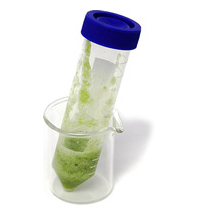 Metoda QuEChERS ("catchers")- Quick, Easy, Cheap, Effective, Rugged, and Safe - byla vyvinuta a publikována institutem US Department of Agriculture Eastern Regional Research Center ve Wyndmooru, PA.(1) Vědečtí pracovníci hledali jednoduchou, efektivní a levnou cestu pro extrakci a přečištění vzorků pro reziduální analýzu pesticidů s cílem nahradit modifikované extrakční metody, které jsou vysoce účinné a robustní, ale také naročné na vybavení laboratoře a tedy i drahé. Extrakce na tuhou fázi (SPE) je také účinná metoda, ale v případě komplexních matric je nutné použít více jednotlivých kolonek s různými sorbenty pro odstranění mnoha skupin interferujících látek. Nová metoda QuEChERS odstraňuje sacharidy, lipidy, organické kyseliny, steroly, proteiny, barviva a vodu. Je jednoduchá a levná.
Metoda QuEChERS ("catchers")- Quick, Easy, Cheap, Effective, Rugged, and Safe - byla vyvinuta a publikována institutem US Department of Agriculture Eastern Regional Research Center ve Wyndmooru, PA.(1) Vědečtí pracovníci hledali jednoduchou, efektivní a levnou cestu pro extrakci a přečištění vzorků pro reziduální analýzu pesticidů s cílem nahradit modifikované extrakční metody, které jsou vysoce účinné a robustní, ale také naročné na vybavení laboratoře a tedy i drahé. Extrakce na tuhou fázi (SPE) je také účinná metoda, ale v případě komplexních matric je nutné použít více jednotlivých kolonek s různými sorbenty pro odstranění mnoha skupin interferujících látek. Nová metoda QuEChERS odstraňuje sacharidy, lipidy, organické kyseliny, steroly, proteiny, barviva a vodu. Je jednoduchá a levná.
Tým vědců vyvinul jednoduchou medodu, skládající se ze dvou kroků. První krok procedury je extrakce zhomogenizovaného vzorku a frakcionace pomocí organického rozpouštědla a roztoků solí. Druhý krok je extrakce a přečištění organické vrstvy s pomocí dispersivní SPE techniky. Ke směsi adsorbentů je přidán 1 ml organického rozpouštědla z kroku 1, obsah je důkladně promíchán a zcentrifugován. Nyní je připraven čistý extrakt pro analýzu různými GC a HPLC technikami. (2) Validační data metody QuEChERS jsou k dispozici pro širokou škálu pesticidů v několika běžných potravinách na www.quechers.com.
Použitá dispersivní SPE metoda, množství a typy adsorbentů, pH nebo polarita rozpouštědel může být jednoduše optimalizována pro různé matrice a analyty. Výsledky tohoto postupu jsou ověřovány a kvalifikovány několika USDA (US Dep. of Agriculture) a administrativními potravinářskými laboratořemi a jsou tak plně akceptovány pro mnoho matric reziduální analýzy pesticidů.
Produkty Resprep™ ještě více tento postup zjednodušují. Cetrifugační zkumavky, dostupné v rozměrech 2 a 15 ml, obsahují síran hořečnatý (odstranění vody z organické frakce) a PSA* adsorbent (odstranění sacharidů a mastných kyselin), dále mohou být s přídavkem grafitizovaného uhlíku (odstranění pigmentů a sterolů) nebo adsorbentu C18 (odstranění nepolárních interferujících látek).
Pokud jste nespokojení s časem a výší finančních nákladů vynaložených na předúpravu vzorků pro reziduální analýzu pesticidů, vyzkoušejte tuto novou jednoduchou a ekonomickou metodu.
Více informací o jednotlivých produktech naleznete zde.
Reference:
- Anastassiades, M., S.J. Lehotay, D. Stajnbaher, F.J. Schenck, Fast and Easy Multiresidue Method Employing Acetonitrile Extraction/Partitioning and "Dispersive Solid-Phase Extraction" for the Determination of Pesticide Residues in Produce, J AOAC International, 2003, vol 86 no 22, pp 412-431.
- Schenck, F.J., SPE Cleanup and the Analysis of PPB Levels of Pesticides in Fruits and Vegetables. Florida Pesticide Residue Workshop, 2002
Fáze MEPS
Jehly BIN se dodávají s různými SPE fázemi. Rozměry lože sorbentu zajišťují, že separační schopnost sorbentu je identická s konvenční SPE. Příprava vzorků komplexních biologických matric je pomocí MEPS jednoduchá a snižuje nároky na objem vzorku a používaných reagencií ve srovnání se SPE nebo jinými „mikroextrakčními technikami“. MEPS využívá separaci pomocí reverzní fáze, normální fáze, směsného módu a iontové výměny. Jelikož MEPS umožňuje práci s malými objemy (až 10µL), je vhodnou technikou pro přímé propojení s LC-MS systémy. Současný rozsah stříkaček umožňuje ruční použití nebo využití automatických dávkovačů Thermo Scientific, CTC Analytics, HTA 300APlus a Varian 8400 bez nutnosti jejich úpravy. Jehly BIN jsou v provedení pro LC a GC aplikace. Jehly jsou baleny v utěsněných fóliích po 5 kusech.
SGE
| Fáze | Velikost částic (µm) | Velikost pórů (A) |
|---|---|---|
| Silikagel | 45 | 60 |
| C2 | 45 | 60 |
| C8 | 45 | 60 |
| C8+SCX* | 45 | 60 |
| C18 | 45 | 60 |
*C8+SCX jehly BIN jsou označeny jako M1.
Jehly BIN lze zpravidla použít pro 40 - 100 extrakcí. Obvyklá doba přípravy vzorku je 1 - 2 minuty.
Stacionární fáze
 GC, HPLC, SPE, FLASH- nebo preparativní chromatografie používají širokou řadu stacionárních fází. Na těchto stránkách naleznete bližší informace o jednotlivých typech.
GC, HPLC, SPE, FLASH- nebo preparativní chromatografie používají širokou řadu stacionárních fází. Na těchto stránkách naleznete bližší informace o jednotlivých typech.
Stacionární fáze pro analytické separace
Stacionární fáze pro přípravu vzorků
- SPE
- dSPE (QuEChERS)
- IAC (imunoafinitní kolonky)
- MEPS (mikroextracke na pevné fázi)
- FLASH
- BULK (média pro preparativní chromatografii)
Kovové ferulky SilTite pro GC a GC/MS
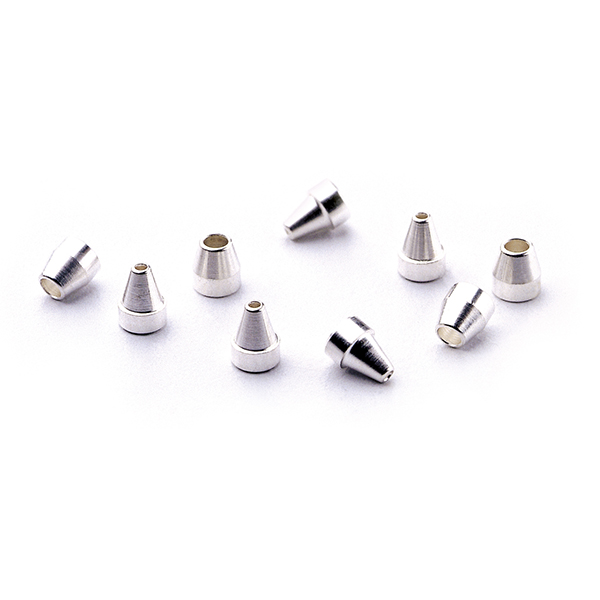 Ferulky SilTite jsou unikátní kovové ferulky designované pro spojení křemenných kapilárních GC kolon a kapilár s hmotnostními spektrometry a GC injektory. Již po prvním správném utažení poskytují ferulky SilTite těsné spojení i po mnoha teplotních cyklech bez nutnosti dalšího datahování. Ferulky SilTite se používají ve spojení s maticemi a fitinkam SGE SilTite s katalogovými čísly:
Ferulky SilTite jsou unikátní kovové ferulky designované pro spojení křemenných kapilárních GC kolon a kapilár s hmotnostními spektrometry a GC injektory. Již po prvním správném utažení poskytují ferulky SilTite těsné spojení i po mnoha teplotních cyklech bez nutnosti dalšího datahování. Ferulky SilTite se používají ve spojení s maticemi a fitinkam SGE SilTite s katalogovými čísly:
- SGE*073200
- SGE*073201
- SGE*073202
- SGE*073203
Proč volit ferulky SilTite?
- eliminace netěsností (viz obrázky níže)
- není nutné další dotahování, a to dokonce po více teplotních cyklech
- ferulky zůstávají trvale fixovány na koloně a nepřilnou k matici
- žádná kontaminace z materiálu Vespel nebo grafit - 100% kov
- ideální pro vysokotlaké aplikace (fast GC)
- vhodné pro připojení k injektorům
- maximální teplota >500°C
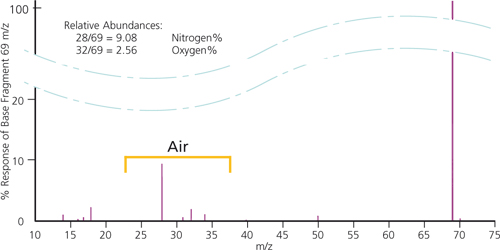
Obu 1. Stopy vzduchu v MS systému po 5 teplotních cyklech při použití ferulek Vespel/grafit.
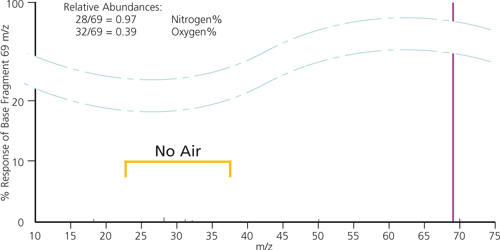
Obr 2. MS spektrum po 5 teplotních cyklech při použití ferulek Siltite. (U MS, nejsou přítomny netěsnosti dokonce i po 400 teplotních cyklech 70ºC a 400ºC).




